It’s not uncommon for bodybuilders to glance at the straps of the TRX Suspension Trainer and wonder, “How can these floppy pieces of nylon webbing possibly help me add muscle mass?”
The answer, of course, is grounded in the science of how muscle is actually built. When a significant load is applied to the muscles, a chain of reactions occur, including muscle damage and altered hormonal balance, that leads to an increase in thickness and number of myofibrils (i.e., hypertrophy). The key is that the load placed on the muscles must be significant enough to require the muscles to adapt.
Which brings us back to the question about the TRX Suspension Trainer: Can it provide a great enough load to actually build muscle? Here’s what the research says:
- Compared to traditional resistance training, TRX suspension training programs produce similar results in muscular strength, muscular endurance, flexibility and balance in both younger and older adults (Janot et al., 2013).
- TRX Suspension Training workouts cause similar growth hormone responses during and post-workout as traditional resistance training (Dudgeon et al., 2011).
- A single bout of TRX exercise creates a greater testosterone-to-cortisol ratio, and thus potential for enhanced muscle growth, than traditional resistance-training exercise (Scheett et al., 2011).
- Inverted TRX rows stimulate greater activation of the latissimus dorsi, upper-back and hip-extensor muscles than free-weight rowing exercises. Additionally, TRX suspended push-ups elicit greater upper-body and abdominal muscle activity compared to standard ground-based push-ups (McGill et al., 2014).
Now that you’ve seen the evidence, here are a few exercises to incorporate into your clients’ strength-training workouts to help them increase strength and build muscle. Just be sure they can maintain proper form on similar exercises before attempting these high-tension, loaded exercises.
1. TRX Inverted Row
With the Suspension Trainer over-shortened, orient you body so that you are ground-facing the anchor point. Hinge the hips into a plank, ensuring your shoulders are lower than your knees and your body is in a straight line. Maintaining the active plank, pull your chest to the handles and return.
Crank it up: Combine this exercise with a TRX Inverted Biceps Curl.
Step it back: Perform a standard TRX Low Row.
TRX Single-leg Squat with Kettlebell
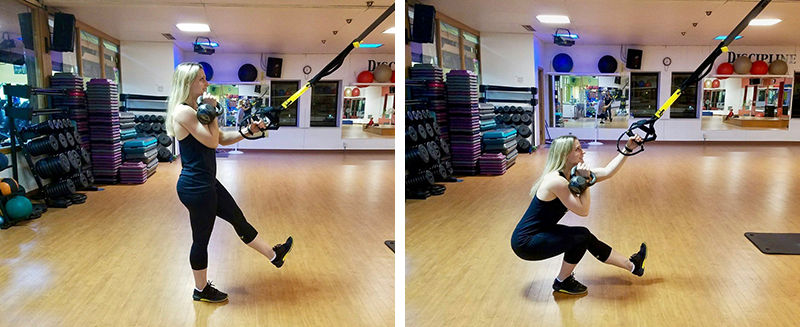
Adjust the TRX Suspension Trainer to mid-length and single-handle mode. Stand facing the anchor point with your right foot centered and your left hand grasping the handle. In your right hand, hold a kettlebell (or dumbbell) in a racked position. Maintaining proper spinal alignment as you lower the hips down and back. Press back up to the starting position.
Crank it up: Grab a heavier kettlebell (or dumbbell).
Step it back: Remove the weight and practice the single-leg squat with cross grab—this movement is still quite challenging.
TRX Single-leg Hip Press
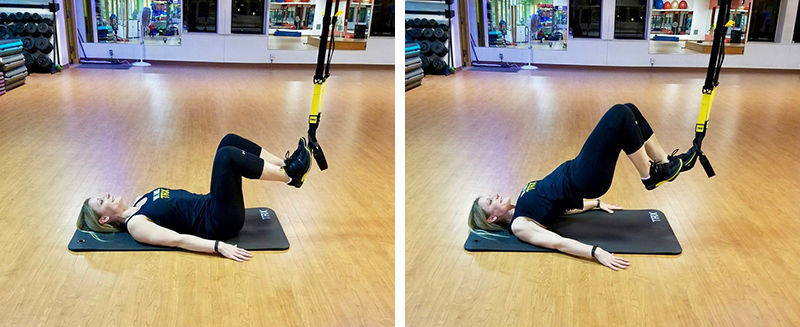
Set the TRX Suspension Trainer at mid-calf length and single-handle mode. Begin ground-facing the anchor point and put the right heel in the foot cradle. Bend both knees to 90 degrees and line the feet up directly below the anchor point. While bracing the core, lift the hips so the body is in one straight line. Lower the hips back to the floor.
Crank it up: Rest a small weight on the hips.
Step it back: Perform a TRX Hip Press with both heels in the foot cradles.
TRX Side Plank With Rotation
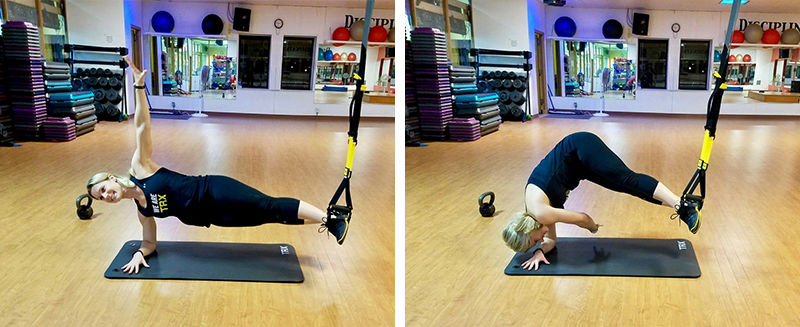
With the straps at mid-calf length, place he toes in the foot cradles and begin ground-sideways to the anchor point. Begin with a solid side plank, with the ears, shoulders, hips, and feet in alignment. Reach the opposite arm under the body while simultaneously lifting the hips, and then return to the perfectly aligned plank.
Crank it up: Try this exercise while balancing on the hand rather than the forearm.
Step it back: Perform a TRX Side Plank but remove the rotations.
TRX Incline Press

Adjust the straps to mid-calf length and single-handle mode. Place one toe in the foot cradle, ground-facing away from the anchor point. Carefully walk he feet behind the anchor point (the farther away, the more challenging the exercise will be). Set the body into a solid active plank and perform a push-up.
Crank it up: Walk back until the point of hitting a handstand.
Step it back: Place the elevated foot on the floor for more support.
TRX Lunge With Weight
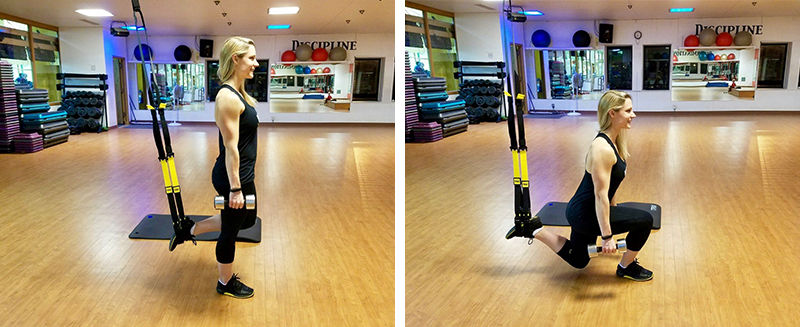
Keep the straps at mid-calf length. Place the right foot into the foot cradles and begin in a half-kneeling position with he front heel about 1 foot in front of he back knee. Grasp the appropriate dumbbells, brace the core and stand up. Lower the back knee just above its original starting position and repeat.
Crank it up: Grab bigger weights.
Step it back: Perform the TRX Lunge without weight or try the TRX Balance Lunge.
References
Dudgeon, W. et al. (2011). Effect of suspension training on growth hormone axis. Journal of Strength and Conditioning Research, 25, S62.?
Janot, J. et al. (2013). Effects of TRX versus traditional resistance training programs on measures of muscular performance in adults. Journal of Fitness Research, 2, 2, 23-38. ?
McGill, S.M. et al. (2014). Analysis of pushing exercises: Muscle activity and spine load while contrasting techniques on stable surfaces with labile suspension strap training system. Journal of Strength and Conditioning Research, 28, 1, 105-116. ?
Scheett, T. et al. (2011). Anabolic hormonal response to an acute bout of suspension training. Journal of Strength and Conditioning Research, 25, S61-S62.




 by
by 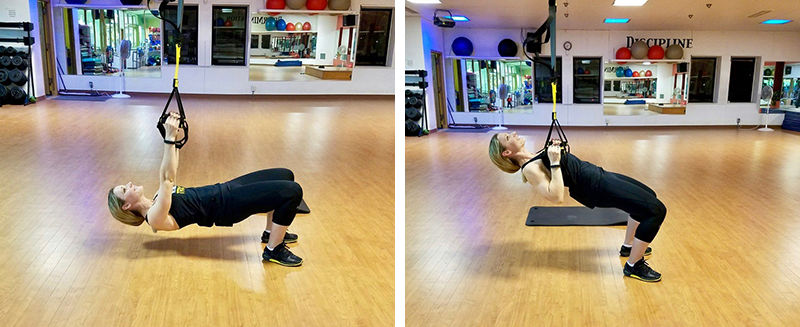









 by
by